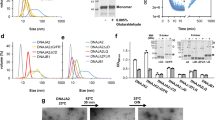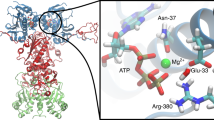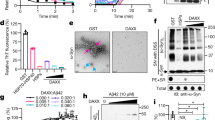Abstract
Channeling of misfolded proteins into repair, assembly or degradation pathways is often mediated by complex and multifunctional cellular factors. Despite detailed structural information, the underlying regulatory mechanisms governing these factors are not well understood. The extracytoplasmic heat-shock factor DegP (HtrA) is a well-suited model for addressing mechanistic issues, as it is regulated by the common mechanisms of allostery and activation by oligomerization. Site-directed mutagenesis combined with refolding and oligomerization studies of chemically denatured DegP revealed how substrates trigger the conversion of the resting conformation into the active conformation. Binding of specific peptides to PDZ domain-1 causes a local rearrangement that is allosterically transmitted to the substrate-binding pocket of the protease domain. This activated state readily assembles into larger oligomeric particles, thus stabilizing the catalytically active form and providing a degradation cavity for protein substrates. The implications of these data for the mechanism of protein quality control are discussed.
This is a preview of subscription content, access via your institution
Access options
Subscribe to this journal
Receive 12 print issues and online access
$189.00 per year
only $15.75 per issue
Buy this article
- Purchase on Springer Link
- Instant access to full article PDF
Prices may be subject to local taxes which are calculated during checkout







Similar content being viewed by others
References
Kolmar, H., Waller, P. & Sauer, R. The DegP and DegQ periplasmic endoproteases of Escherichia coli: specificity for cleavage sites and substrate conformation. J. Bacteriol. 178, 5925–5929 (1996).
Spiess, C., Beil, A. & Ehrmann, M. A temperature-dependent switch from chaperone to protease in a widely conserved heat shock protein. Cell 97, 339–347 (1999).
Meltzer, M. et al. Allosteric activation of HtrA protease DegP by stress signals during bacterial protein quality control. Angew. Chem. Int. Edn. Engl. 47, 1332–1334 (2008).
Krojer, T. et al. Interplay of PDZ and protease domain of DegP ensures efficient elimination of misfolded proteins. Proc. Natl. Acad. Sci. USA 105, 7702–7707 (2008).
Krojer, T. et al. Structural basis for the regulated protease and chaperone function of DegP. Nature 453, 885–890 (2008).
Jiang, J. et al. Activation of DegP chaperone-protease via formation of large cage-like oligomers upon binding to substrate proteins. Proc. Natl. Acad. Sci. USA 105, 11939–11944 (2008).
Clausen, T., Southan, C. & Ehrmann, M. The HtrA family of proteases. Implications for protein composition and cell fate. Mol. Cell 10, 443–455 (2002).
Page, M.J. & Di Cera, E. Evolution of peptidase diversity. J. Biol. Chem. 283, 30010–30014 (2008).
Wilken, C., Kitzing, K., Kurzbauer, R., Ehrmann, M. & Clausen, T. Crystal structure of the DegS stress sensor: how a PDZ domain recognizes misfolded protein and activates a protease domain. Cell 117, 483–494 (2004).
Murwantoko et al. Binding of proteins to the PDZ domain regulates proteolytic activity of HtrA1 serine protease. Biochem. J. 381, 895–904 (2004).
Gupta, S. et al. The carboxy terminal tail of presenilin regulates Omi/HtrA2 protease activity. J. Biol. Chem. 279, 45844–45854 (2004).
Iwanczyk, J. et al. Role of the PDZ domains in Escherichia coli DegP protein. J. Bacteriol. 189, 3176–3186 (2007).
Hasselblatt, H. et al. Regulation of the sE stress response by DegS: how the PDZ domain keeps the protease inactive in the resting state and allows integration of different OMP-derived stress signals upon folding stress. Genes Dev. 21, 2659–2670 (2007).
Krojer, T., Garrido-Franco, M., Huber, R., Ehrmann, M. & Clausen, T. Crystal structure of DegP (HtrA) reveals a new protease-chaperone machine. Nature 416, 455–459 (2002).
Shen, Q.T. et al. Bowl-shaped oligomeric structures on membranes as DegP's new functional forms in protein quality control. Proc. Natl. Acad. Sci. USA 106, 4858–4863 (2009).
Meltzer, M. et al. Structure, function and regulation of the conserved serine proteases DegP and DegS of Escherichia coli. Res. Microbiol. 160, 660–666 (2009).
Ortega, J., Iwanczyk, J. & Jomaa, A. Escherichia coli DegP: a structure-driven functional model. J. Bacteriol. 191, 4705–4713 (2009).
Hauske, P. et al. Selectivity profiling of DegP substrates and inhibitors. Bioorg. Med. Chem. 17, 2920–2924 (2009).
Perona, J.J. & Craik, C.S. Structural basis of substrate specificity in the serine proteases. Protein Sci. 4, 337–360 (1995).
Hedstrom, L. Serine protease mechanism and specificity. Chem. Rev. 102, 4501–4524 (2002).
Kuriyan, J. & Eisenberg, D. The origin of protein interactions and allostery in colocalization. Nature 450, 983–990 (2007).
Hauske, P., Ottmann, C., Meltzer, M., Ehrmann, M. & Kaiser, M. Allosteric regulation of proteases. ChemBioChem 9, 2920–2928 (2008).
Heink, S., Ludwig, D., Kloetzel, P.M. & Kruger, E. IFN-gamma-induced immune adaptation of the proteasome system is an accelerated and transient response. Proc. Natl. Acad. Sci. USA 102, 9241–9246 (2005).
Kirstein, J., Moliere, N., Dougan, D.A. & Turgay, K. Adapting the machine: adaptor proteins for Hsp100/Clp and AAA+ proteases. Nat. Rev. Microbiol. 7, 589–599 (2009).
Korennykh, A.V. et al. The unfolded protein response signals through high-order assembly of Ire1. Nature 457, 687–693 (2009).
Milner, J.M., Patel, A. & Rowan, A.D. Emerging roles of serine proteinases in tissue turnover in arthritis. Arthritis Rheum. 58, 3644–3656 (2008).
Chien, J., Campioni, M., Shridhar, V. & Baldi, A. HtrA serine proteases as potential therapeutic targets in cancer. Curr. Cancer Drug Targets 9, 451–468 (2009).
Hara, K. et al. Association of HTRA1 mutations and familial ischemic cerebral small-vessel disease. N. Engl. J. Med. 360, 1729–1739 (2009).
Vande Walle, L., Lamkanfi, M. & Vandenabeele, P. The mitochondrial serine protease HtrA2/Omi: an overview. Cell Death Differ. 15, 453–460 (2008).
Grau, S. et al. Implications of the serine protease HtrA1 in amyloid precursor protein processing. Proc. Natl. Acad. Sci. USA 102, 6021–6026 (2005).
Harnasch, M. et al. Bacterial expression and two-hybrid systems for human membrane proteins: characterisation of presenilin/amyloid precursor interaction. Mol. Membr. Biol. 21, 373–383 (2004).
Acknowledgements
M.E. was supported by Deutsche Forschungsgemeinschaft and the Fonds der Chemischen Industrie.
Author information
Authors and Affiliations
Contributions
M. Merdanovic, N.M., M. Meltzer, S.P., A.A., R.M., P.H. and L.N.-S. performed the experiments; A.R.C., M.K., R.H. and M.E. planned the work and wrote the paper.
Corresponding author
Ethics declarations
Competing interests
The authors declare no competing financial interests.
Supplementary information
Supplementary Text and Figures
Supplementary Figures 1–3 and Supplementary Note (PDF 364 kb)
Rights and permissions
About this article
Cite this article
Merdanovic, M., Mamant, N., Meltzer, M. et al. Determinants of structural and functional plasticity of a widely conserved protease chaperone complex. Nat Struct Mol Biol 17, 837–843 (2010). https://doi.org/10.1038/nsmb.1839
Received:
Accepted:
Published:
Issue Date:
DOI: https://doi.org/10.1038/nsmb.1839
This article is cited by
-
Tailored protein encapsulation into a DNA host using geometrically organized supramolecular interactions
Nature Communications (2017)
-
The crystal structure of Deg9 reveals a novel octameric-type HtrA protease
Nature Plants (2017)
-
Determinants of amyloid fibril degradation by the PDZ protease HTRA1
Nature Chemical Biology (2015)
-
Newly folded substrates inside the molecular cage of the HtrA chaperone DegQ
Nature Structural & Molecular Biology (2012)
-
Substrate-induced remodeling of the active site regulates human HTRA1 activity
Nature Structural & Molecular Biology (2011)



